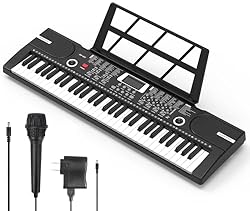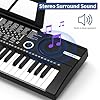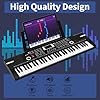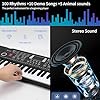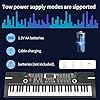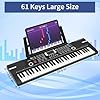Table of Contents
Piano Learning Strategies for Visual Learners
For visual learners, mastering the piano can be both a delightful and challenging journey. This group thrives on visual stimulation and can greatly benefit from learning strategies that cater specifically to their strengths. From reading music to recognizing patterns on the keyboard, visual learners have distinct advantages in visual-spatial thinking and memory retention. This introduction explores tailored approaches that enhance the learning experience, emphasizing tools and techniques designed to maximize engagement and effectiveness for visual learners.
Utilizing Visual Aids for Learning Piano Keys
For visual learners, using visual aids can be incredibly helpful when learning to play the piano. These methods tap into the visual learner’s innate ability to process information best when it is seen. Here are some effective visual aids:
P71 Digital Piano Review and Guide
$0.00 (as of November 22, 2025 14:40 GMT -08:00 - More infoProduct prices and availability are accurate as of the date/time indicated and are subject to change. Any price and availability information displayed on [relevant Amazon Site(s), as applicable] at the time of purchase will apply to the purchase of this product.)Wicked - A New Musical Songbook by Stephen Schwartz | Piano Vocal Selections with 13 Broadway Hits | Sheet Music for Piano Voice and Guitar | Authentic Arrangements for Performers Students and Fans
31% OffReady for Theory Level 3 Piano Review Book (Ready for Theory Piano Review Books)
$12.95 (as of November 22, 2025 14:46 GMT -08:00 - More infoProduct prices and availability are accurate as of the date/time indicated and are subject to change. Any price and availability information displayed on [relevant Amazon Site(s), as applicable] at the time of purchase will apply to the purchase of this product.)The Piano Proficiency Exam Review Book
$14.57 (as of November 22, 2025 14:43 GMT -08:00 - More infoProduct prices and availability are accurate as of the date/time indicated and are subject to change. Any price and availability information displayed on [relevant Amazon Site(s), as applicable] at the time of purchase will apply to the purchase of this product.)Color-Coded Key Stickers
One of the most straightforward aids are color-coded key stickers. These can be placed on each piano key to help differentiate between notes. Assigning a unique color to each note (C, D, E, etc.) simplifies the recognition process and helps in memorizing the layout of the piano keyboard more quickly.
Graphical Notation Software
Using graphical notation software such as Synthesia or Piano Marvel can also assist visual learners. These programs display notes in a game-like environment where music notation is shown in real-time, allowing for an interactive learning experience. This method particularly helps in understanding timing and rhythm.
Printed Visual Aids
Another useful tool are printed visual aids. These include large-scale printed images of piano keys with notes labeled, which can be kept nearby as a reference. Additionally, using flashcards with note names and corresponding keys can reinforce knowledge and speed up the learning process.
Scale and Chord Charts
Scale and chord charts display all the keys used in each scale or chord, providing a visual snapshot that can be referenced quickly. These charts are particularly beneficial for visualizing relationships between notes and understanding the structure of music.
Yamaha Arius Series 88-Key Weighted Action Upright Digital Piano, CFX Concert Grand Piano Voice, 3-Pedal Unit, Bench Included, Classic Upright Design, Black YDP145B
17% OffFree Piano - Learn to Play Piano
$0.00 (as of November 22, 2025 22:56 GMT -08:00 - More infoProduct prices and availability are accurate as of the date/time indicated and are subject to change. Any price and availability information displayed on [relevant Amazon Site(s), as applicable] at the time of purchase will apply to the purchase of this product.)Classical Piano for Sleep and Relaxation
$9.99 (as of November 22, 2025 22:56 GMT -08:00 - More infoProduct prices and availability are accurate as of the date/time indicated and are subject to change. Any price and availability information displayed on [relevant Amazon Site(s), as applicable] at the time of purchase will apply to the purchase of this product.)61 keys keyboard piano, Electronic Digital Piano with Built-In Speaker Microphone, Sheet Stand and Power Supply, Portable piano Keyboard Gift Teaching for Beginners
$164.00 (as of November 22, 2025 23:10 GMT -08:00 - More infoProduct prices and availability are accurate as of the date/time indicated and are subject to change. Any price and availability information displayed on [relevant Amazon Site(s), as applicable] at the time of purchase will apply to the purchase of this product.)Augmented Reality (AR) Piano Learning Apps
Emerging technologies like augmented reality (AR) piano learning apps offer a high-tech solution. By using the device’s camera, these apps can superimpose learning material directly onto the piano itself through the screen, making learning interactive and engaging. Apps like AR Pianist allow learners to see notes, scales, and chords directly on their instrument.
Pianote: Lessons for Beginners to Advanced Players
Pianote is excellent for visual learners due to its engaging visuals and step-by-step demonstrations. Each lesson incorporates high-quality video content featuring overhead camera angles so students can clearly see the keys and hand movements. Lessons range from fundamental basics to more advanced playing techniques, making it suitable for learners at different stages. Their structured learning path helps maintain progress and development systematically.
Hoffman Academy: Interactive Piano Learning
Perfect for visual learners, Hoffman Academy utilizes animated videos to make learning piano engaging and entertaining. Visual cues and on-screen notation help in retaining musical concepts. Their lessons start from the very basics, easing into the instrument without overwhelming the student. They also have a unique feature of integrated practice sessions within the tutorials, promoting immediate application of learned skills.
HDpiano: Learn Piano with HD Videos
HDpiano shines in its high-definition video lessons tailored specifically for learning popular songs. This platform is great for visual learners because each tutorial breaks down songs part by part with overhead keyboard views, allowing students to see exactly what and how to play. This approach not only helps in learning songs but also teaches various piano techniques through practical application.
Flowkey: Dynamic Learning Software
Flowkey offers a great interactive experience with real-time feedback and dynamic visual loops for repetitive practice. It uses a combination of video lessons and a scrolling interface displaying the correct keys to hit in sync with the video. This real-time method is extremely beneficial for visual learners as they can both see and follow along with ease. Flowkey covers a wide range of genres and is suitable for learners at all levels.
Josh Wright Piano TV: Advanced Techniques and Application
Josh Wright Piano TV is ideal for intermediate to advanced visual learners. His tutorials focus on classical performances and advanced piano techniques. Videos often include multiple camera angles, highlighting key movements and pedaling. Josh’s explanations help translate complex pieces into achievable sections, fostering a deeper understanding and mastery for serious piano students.
How to Use Color-Coded Sheet Music Effectively
Using color-coded sheet music can be a transformative strategy for visual learners beginning to learn piano. Here’s how to implement this method effectively:
1. Choose a Color Scheme
Start by assigning a specific color to each note or a group of notes. For instance, C can be red, D can be blue, and so on. Ensure that the colors are distinct from each other to avoid confusion.
2. Apply Colors Consistently
Consistency is key in color-coding. Use the same color for each note across all your sheet music. This repetition will help reinforce note recognition and assist in faster learning.
3. Use Highlighter Pens or Color Stickers
Apply colors to your sheet music using highlighter pens or colored stickers. Highlighters are good for marking on the paper without obscuring the note, while stickers can be used for more temporary markings.
4. Combine with Traditional Learning
Integrate color-coded learning with traditional sheet music reading. Initially, you can practice with colored sheets, but gradually mix in uncolored sheets to enhance your ability to read standard music notation.
5. Practice Regularly
Regular practice with color-coded music sheets is essential. It familiarizes the student with various musical pieces and enhances their ability to associate colors with specific notes automatically.
6. Digital Tools and Apps
Consider using digital tools and apps that support color-coded music learning. These tools can offer interactive experiences and instant feedback, which are invaluable for a visual learner.
7. Progress to More Complex Pieces
As skills improve, gradually introduce more complex pieces that challenge the learner’s ability to recognize notes quick and accurately. This gradual increase in difficulty will help solidify the knowledge gained through color-coded practice.
Creating Visual Reminders for Piano Chords and Scales
Visual learners benefit immensely from having clear, graphic representations of information. When learning piano chords and scales, creating visual reminders can streamline the education process and make practice sessions more effective. Here are some methods to create useful visual aids:
Using colors to differentiate notes in chords and scales helps in memorizing their positions and relationships on the keyboard. You can create a color-coded keyboard diagram where each note of a scale or chord is marked with a specific color. For example, use red for the root note, blue for the third, green for the fifth, and so forth. This method visually segments the keyboard in a way that is easy to understand at a glance.
Prepare printed charts that display the structure of each scale and chord. These charts should highlight the intervals and finger positions needed to play them. Placing these charts on the music stand while practicing can serve as a quick reference. You can also use software tools to generate these charts tailored to specific keys.
Create a set of flashcards for chords and scales. Each card should feature the name of the chord or scale on one side and a diagram of how it is played on the keyboard on the other side. This visual tool is effective for both drilling and testing yourself on the recognition and performance of various chords and scales.
For initial learning stages, placing sticky notes with note names or chord/scale types directly on the piano keys can be helpful. This technique provides immediate visual cues and helps in memorizing the layout of notes in different scales and chords. Remember to gradually phase out the use of sticky notes as you become more familiar with the keys to strengthen your memory recall.
Many modern apps and software provide interactive and customizable visuals for learning piano. These tools often feature on-screen keyboards and can light up the relevant keys for chords and scales, offering a dynamic and engaging way to learn. Some apps also allow you to adjust settings according to your level, pace, and the specific scales or chords you’re focused on.
By incorporating these visual reminders in your practice routine, you can enhance your ability to quickly learn and recall important information about piano chords and scales, making your learning process more fluid and intuitive.
Visualizing Music Theory to Enhance Understanding
For visual learners, understanding music theory through visualization techniques can be particularly effective. Here are some strategies to help these learners grasp complex musical concepts on the piano using visual tools:
Use of Keyboard Diagrams
Keyboard diagrams are essential for visual learners to locate notes and visualize scales and chords. By highlighting keys on a diagram in different colors, learners can easily understand the structure and relationship between notes in various scales and chords, enhancing their spatial recognition on the keyboard.
Color-Coded Sheet Music
Integrating color coding in sheet music helps in distinguishing different musical elements. Assigning a specific color to various notes or chords can aid in quickly recognizing patterns and sequences in music, making it easier to read and memorize music for performance.
Graphical Representations of Musical Structures
Visual learners can benefit from graphical representations of musical structures. For example, using circle diagrams to depict the Circle of Fifths, or bar graphs to visually understand dynamic changes in a piece, can clarify theoretical concepts that might seem abstract if only described verbally or through written text.
Animated Music Theory Applications
Several interactive and animated apps are designed to teach music theory through engaging visuals. These applications often use animations to demonstrate how notes interact, provide visual feedback on ear training exercises, or simulate piano playing to explain theoretical concepts in real-time.
Video Tutorials with Visual Aids
Video tutorials that incorporate visual aids such as on-screen keyboards, animated notes, and highlighted sheet music are incredibly beneficial. These tutorials can demonstrate finger placement, timing, and rhythm through visually engaging content, making complex theoretical ideas more accessible.
Interactive Learning Tools
Using interactive learning tools like digital pianos that connect to learning software can provide a visual and tactile learning experience. These tools often include features that light up keys to teach scales, chords, and songs, providing immediate visual feedback that helps in embedding musical knowledge.
Conclusion
In conclusion, visual learners benefit immensely from piano learning strategies tailored to their innate strengths. Utilizing visual aids, embracing video tutorials, incorporating color-coded materials, and maintaining a well-structured and visually organized learning environment will maximize their ability to understand and retain musical concepts and skills. These strategies not only enhance their learning experience but also ensure they remain motivated and engaged throughout their musical journey.


























